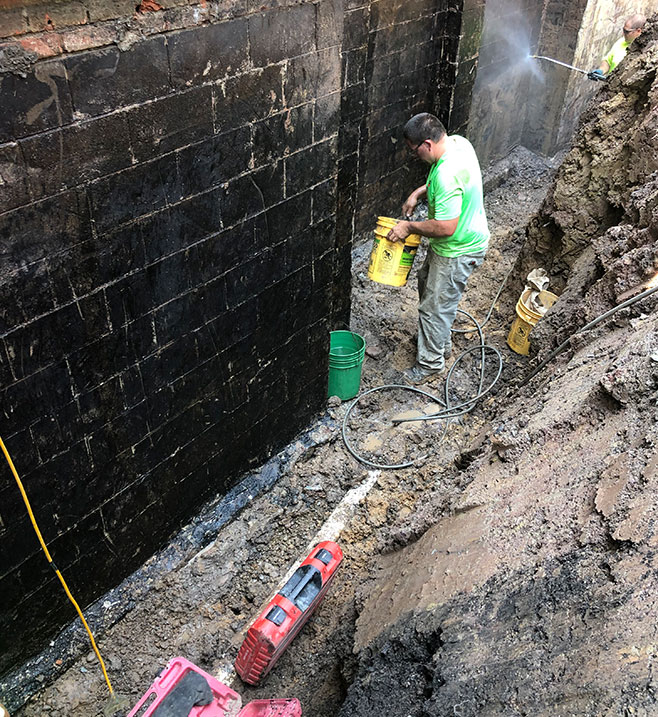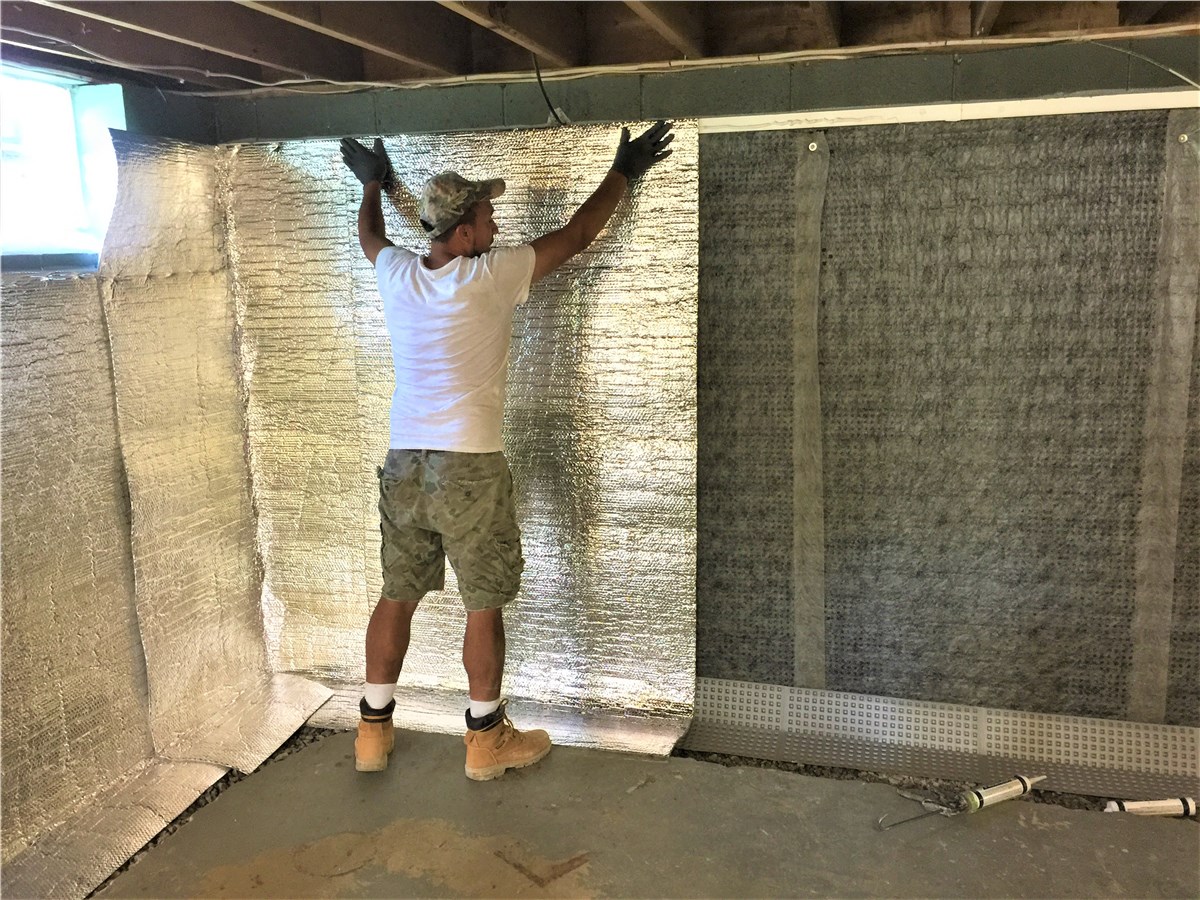Basement Leak Repair Toronto: Expert Solutions for a Dry Basement
Basement Leak Repair Toronto: Expert Solutions for a Dry Basement
Blog Article
Recognizing the Relevance of Structure Waterproofing for Long-Lasting Structural Integrity
In the world of property upkeep, foundation waterproofing stands as an essential aspect in protecting architectural stability. While frequently forgotten, the risks postured by water breach can lead to costly and substantial damage that weakens the really structure of a building. Recognizing the subtleties of waterproofing can expose just how it acts as a critical defense system against these hazards.
Dangers of Water Intrusion
Water intrusion's effect on a structure can be substantial, leading to a host of potential troubles that endanger the stability of a structure's structure. As dampness permeates right into the foundation, it can weaken the architectural parts, causing splits and disintegration in time. This seepage not only reduces the structure's stamina however also postures a risk to the entire building's stability. Relentless water direct exposure can cause the development of mold and mildew and mildew, exacerbating health problems for occupants and enhancing upkeep prices.
Moreover, water breach can contribute to the wear and tear of building products. Additionally, water breach often leads to boosted humidity levels within the structure, which can impact electrical systems and other infrastructure.
An additional significant risk connected with water breach is soil instability. Excess moisture can modify the composition of the dirt bordering the structure, causing irregular settling and further structural damages - basement waterproofing Toronto. Promptly resolving water breach is important to preserving the durability and security of any kind of building

Benefits of Waterproofing
Applying structure waterproofing is a vital step in protecting a building from the destructive results of water intrusion. One of the key benefits of waterproofing is the preservation of architectural stability. Water infiltration can wear down the structure, bring about splits, weakening the general structure, and possibly leading to expensive repairs. By producing an obstacle versus wetness, waterproofing helps maintain the structure's stamina and resilience over time.
Furthermore, waterproofing significantly improves interior air quality. Wetness seepage can promote mold and mildew and mold development, which not only harms structure products but additionally postures health and wellness dangers to occupants. A properly waterproofed structure minimizes these dangers, contributing to a much healthier indoor atmosphere.
Moreover, waterproofing enhances property value. A well-protected structure is an appealing feature for possible purchasers, as it shows positive upkeep and decreases the possibility of future architectural issues. This investment not just safeguards the present state of the residential or commercial property however also adds long-term value.
Lastly, foundation waterproofing adds to energy performance. By protecting against dampness from entering the structure, it helps in preserving constant interior temperature levels, thus decreasing the need for too much heating or air conditioning and bring about energy cost savings.
Common Waterproofing Methods
When it involves safeguarding a structure's structure, choosing the appropriate waterproofing technique is critical for effective security against wetness intrusion. Different techniques are utilized based on the certain needs and problems of the framework. One of one of the most usual methods is the application of fluid waterproofing membrane layers. These membranes, usually made from polymers, are used as a fluid to form a seamless, sturdy obstacle against water infiltration.
Another widespread approach is the installation of sheet membrane layers, which are pre-formed sheets of water resistant material, commonly asphalt or polyvinyl chloride (PVC), that are followed the structure walls. These sheets give robust security and are particularly efficient in locations with high groundwater levels.
Cementitious waterproofing is another widely-used solution, particularly in new constructions. This includes using a cement-based compound mixed with additives to create a waterproof layer. It is very easy to use and affordable, making it a prominent option for domestic buildings.

Indications of Foundation Damage
To preserve the integrity of a structure's structure, identifying the indicators of potential damage is as vital as choosing the ideal waterproofing methods. Prompt recognition of these indicators can protect against expensive repair work and make sure durable structural security. One of the most evident indicators of foundation damages is the look of splits in the wall surfaces, floorings, or foundation itself. These can differ in size and shape, but horizontal or stair-step cracks often suggest considerable architectural problems.
Unequal floorings are an additional common sign, Continue typically caused by the settling or moving of the foundation. Homeowners may likewise see doors and windows coming to More hints be hard to close or open, showing possible imbalance due to structure motion. Water intrusion signs, such as wetness, mold and mildew, or mildew in the cellar, recommend poor waterproofing or drainage issues, which can exacerbate structure issues.

Selecting the Right Contractor
Choosing the best specialist is vital for making sure successful foundation waterproofing jobs. Begin by researching prospective specialists with a tested track document in foundation waterproofing.
It is essential to get multiple quotes to contrast rates and extent of job supplied by each professional. Be careful of quotes that are considerably reduced than others, as this may suggest below average products or handiwork.
During consultations, analyze their interaction skills and desire to address inquiries, which are signs of a professional's dedication to client complete satisfaction. Ensure they offer a thorough contract describing timelines, warranties, expenses, and products. Lastly, verify their understanding of neighborhood building ordinance and guidelines to prevent potential conformity concerns. By taking these actions, you can pick a professional that go now will certainly supply high quality, resilient waterproofing options.
Final Thought
Structure waterproofing is vital for keeping architectural stability and avoiding potential damages triggered by water breach. By applying effective waterproofing techniques, the threats of mold and mildew growth, product wear and tear, and soil instability are dramatically decreased. This conservation not just safeguards the residential property's worth but also adds to enhanced indoor air quality and energy performance. Careful option of suitable waterproofing methods and qualified service providers is critical for guaranteeing lasting defense and sturdiness of foundational frameworks.
In the world of building upkeep, foundation waterproofing stands as an essential aspect in protecting architectural stability.Executing foundation waterproofing is a crucial action in shielding a building from the destructive effects of water invasion. One of the most evident signs of structure damages is the look of splits in the walls, floors, or foundation itself. Water intrusion indicators, such as wetness, mold and mildew, or mildew in the cellar, suggest insufficient waterproofing or drainage concerns, which can worsen structure issues.
Foundation waterproofing is vital for maintaining architectural integrity and preventing prospective damages triggered by water breach. - Leaky basement Toronto
Report this page